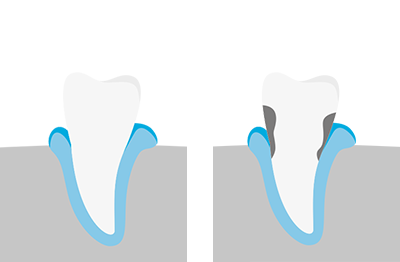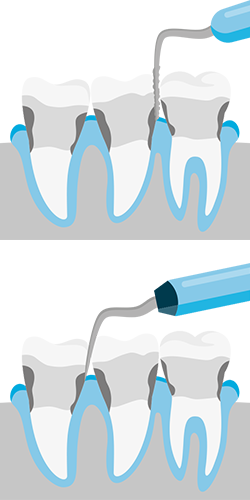Gum treatment
Healthy teeth are often associated with brilliant white teeth. For successful aesthetics, however, the gums with their course also play an important role. Because behind them is the “periodontal apparatus”. This describes the tissue that holds the teeth firmly in the bone. Unfortunately, this tissue can also become diseased.
The disease of the periodontium
The technical term for the periodontal apparatus is “peridontium”. If it becomes inflamed, it is called periodontitis. Responsible for this are bacteria that manifest themselves in the gap between the tooth and the gums in the direction of the root tip. Initially, the clinical picture is unremarkable. You only notice that the gums bleed more often due to the existing inflammation.

What are the consequences?
If the inflammation progresses, the bone and periodontium slowly retract. This makes the root of the tooth visible and the tooth appears longer. Over time, the teeth become mobile and biting can be more difficult. Chewing can therefore also cause pain. If the disease spreads further, tooth positions can change. In the end, teeth may be lost.
How can we help?
First of all, the extent of the disease must be determined. For this purpose the gum pockets are raised. The distance is measured in millimetres between the upper edge of the gums and the deepest point of the pocket.
With the help of an x-ray image, the findings are supplemented to get an estimate of how much the bone has receded.
The therapy involves cleaning the root surface with ultrasound and hand instruments. This removes the bacteria, which are firmly embedded in their biofilm on the surface. Repeated sessions (supportive periodontitis therapy) ensure that the therapy is successful in the long term by regular, renewed cleaning.

What can you expect?
At the beginning of the treatment is the diagnosis. The diagnosis is confirmed by the periodontal examinations described above and, if necessary, an X-ray. This is followed by a professional tooth cleaning and an individual adjustment of your oral hygiene. These are important prerequisites for the best possible success. During professional dental cleaning, all plaque (soft/hard/ discolouration) that lies above the gums is removed.
The actual active treatment consists of cleaning the root surface as described above using ultrasound and hand instruments to remove the bacterial plaque.
What can you do yourself?
After periodontal therapy, you should maintain very careful oral hygiene and have your teeth checked regularly by your dentist. If a local inflammation reoccurs, you can act immediately and remove the bacterial plaque. To ensure that this occurs as seldom as possible, regular recleaning under the gumline is indispensable. This involves carefully removing the plaque from all teeth and practising efficient oral hygiene. Your dentist will determine the necessary interval for your visit to the professional dental cleaning individually based on the severity of your gum disease.
You can reach us by phone on +352 290 022.
Opening times: Monday & Tuesday 8:00 a.m. – 6:00 p.m., Wednesday 8:00 a.m. – 2:00 p.m., Thursday 11:00 a.m. – 6:00 p.m. & Friday 8:00 a.m. – 1:00 p.m.
Alternatively, you can also send us an email to kontakt@drjung.lu . or an WhatsApp to +621 236 568
